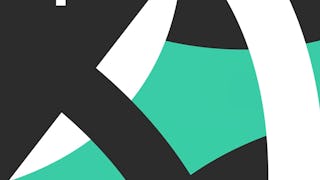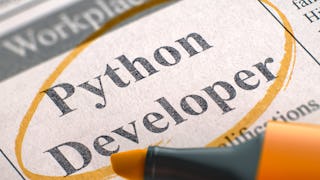This course provides an introduction to programming and the Python language. Students are introduced to core programming concepts like data structures, conditionals, loops, variables, and functions. This course includes an overview of the various tools available for writing and running Python, and gets students coding quickly. It also provides hands-on coding exercises using commonly used data structures, writing custom functions, and reading and writing to files. This course may be more robust than some other introductory python courses, as it delves deeper into certain essential programming topics.



Introduction to Python Programming
This course is part of Introduction to Programming with Python and Java Specialization

Instructor: Brandon Krakowsky
111,954 already enrolled
Included with
(1,228 reviews)
Recommended experience
What you'll learn
Identify core aspects of programming and features of the Python language
Understand and apply core programming concepts like data structures, conditionals, loops, variables, and functions
Use different tools for writing and running Python code
Design and write fully-functional Python programs using commonly used data structures, custom functions, and reading and writing to files
Skills you'll gain
Details to know

Add to your LinkedIn profile
12 assignments
See how employees at top companies are mastering in-demand skills

Build your subject-matter expertise
- Learn new concepts from industry experts
- Gain a foundational understanding of a subject or tool
- Develop job-relevant skills with hands-on projects
- Earn a shareable career certificate

There are 4 modules in this course
This first module covers an intro to programming and the Python language. We’ll start by downloading and installing the necessary tools to begin programming and writing code in Python. After learning how to print to the console, we’ll get an understanding of Python’s basic data types, and how to do simple math. We’ll follow up by creating our first Python script, and learn how to define and assign variables, while controlling the flow of our program using conditionals. We’ll also learn how to get input from the user, including some very basic error checking. Let’s get started!
What's included
42 videos11 readings3 assignments2 programming assignments
We’ll start this module with a brief intro to lists, one of Python’s most commonly used data structures. We’ll learn just enough to get us started with loops, which are used to repeat a process or run a block of code multiple times. We’ll get into functions, which are blocks of organized code used to perform a single, related action. We’ll review some of Python’s built-in functions and learn how to design our own user-defined functions to use as building blocks in our own programs. Along the way, we’ll learn best practices for documenting our code for 2 different audiences: The users who are using our code and want to understand it at a high level, and the programmers who are reading it and want to know how it works.
What's included
31 videos2 readings3 assignments1 programming assignment
In this module, we’re going to start using PyCharm, another IDE for writing and running Python code. It has enhanced features that go way beyond the limited functionality of IDLE, and it’s also an industry standard. After revisiting lists, including more advanced usage of the commonly used sequence, we’ll take a deep dive into two other very important data structures : sets and tuples. We’ll learn how they can be leveraged to both store and manipulate information. And while we already have some experience working with strings, this module will explore the intricacies and more powerful functionality of strings.
What's included
16 videos3 readings3 assignments1 programming assignment
There are multiple ways of loading and storing data in Python. Information can be saved in dictionaries, a data structure that is extremely useful for storing multiple attributes (or data points) about a single thing. Data can also be stored in external files and then loaded into Python. This module will allow us to work with dictionaries in a variety of ways and to interact with the local file system by opening, reading from, and writing to, external files. With these added skills, you’ll begin to get a better sense of the dynamic power of Python and how it can be easily integrated with other systems.
What's included
17 videos3 readings3 assignments1 programming assignment
Earn a career certificate
Add this credential to your LinkedIn profile, resume, or CV. Share it on social media and in your performance review.
Instructor

Offered by
Explore more from Software Development
 Status: Preview
Status: PreviewUniversity of Leeds
 Status: Free Trial
Status: Free Trial Status: Free Trial
Status: Free TrialDuke University
 Status: Free Trial
Status: Free TrialRice University
Why people choose Coursera for their career




Learner reviews
1,228 reviews
- 5 stars
70.78%
- 4 stars
20.09%
- 3 stars
4.96%
- 2 stars
2.03%
- 1 star
2.11%
Showing 3 of 1228
Reviewed on Aug 9, 2022
Although the homework gets difficult, it is progressive and is manageable is we spend enough time on it.highly recommending this class to people like me with no coding expereience!
Reviewed on Jul 19, 2023
I am happy to say thanks to the tutor and coursera platform for providing this opportunity. Personally i feel about the course is that assignments are quite difficult for beginners. Thank you
Reviewed on Apr 14, 2024
I really enjoyed this course. It was well paced and covered the basics nicely. The practice exercises were hard, but made sure you learned all the key concepts.

Open new doors with Coursera Plus
Unlimited access to 10,000+ world-class courses, hands-on projects, and job-ready certificate programs - all included in your subscription
Advance your career with an online degree
Earn a degree from world-class universities - 100% online
Join over 3,400 global companies that choose Coursera for Business
Upskill your employees to excel in the digital economy
Frequently asked questions
No, definitely not! This Specialization is intended for anyone who has an interest in problem solving and wants to learn introductory Python or Java. No prior computer science or programming experience is required.
The only math that learners will need for this Specialization is arithmetic and basic concepts in logic.
This course is the first in the Introduction to Programming with Python and Java Specialization. If you enjoyed it, we recommend Courses 2, 3 and 4 in the series!
If you would like to learn the fundamentals of computer science beyond the basics of programming, consider applying to the Master of Computer and Information and Technology (MCIT) at the University of Pennsylvania, an Ivy League computer science master’s program for people without a computer science background. For an on-campus experience, explore here. If you prefer an online setting, apply to MCIT Online. In fact, the lectures in this series are also used in the online degree program! The Specialization certificate will be viewed favorably by the admissions committee, so be sure to mention it when you apply.
More questions
Financial aid available,

